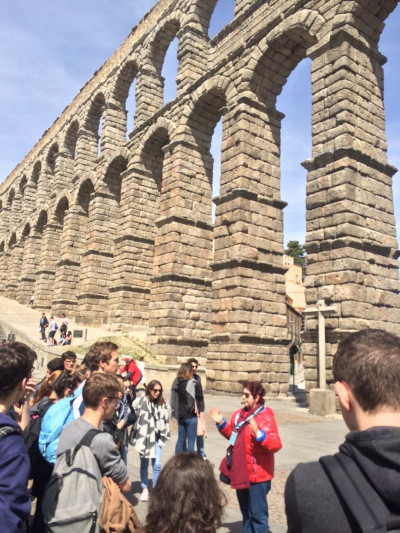8. What are some of the popular places to visit in Spain?
The most popular places are historical cities such as:
Madrid where we recommend the old city centre, the quarter of the Austrias. The Royal Palace, the official residence of the Kings of Spain. The golden triangle of art: Prado, the national art museum, the Reina Sofia museum of 20th C art and the Thyssen Bornemisza museum, a mix of classical and contemporary art.

The Escorial, Madrid © Spanish Confederation of Associations of Tourist Guides
Barcelona the city of Gaudi, the modernist architect. The Cathedral of la Sagrada Familia, the Park Guël, Casa Milà and Casa Batlló are Gaudi’s best-known creations and UNESCO World Heritage Sites. Climb the Montjuïc hill, with its excellent views over the city and visit Barcelona’s Olympic and Sports Museum dedicated to the 1992 Olympic Games.
Toledo the so-called capital of three religions, where Jews, Muslims and Christians lived in harmony for centuries.
Seville with the largest gothic Cathedral in Christendom. The Moorish Alcazar. The oldest Royal Palace in Europe still in use and its lavish gardens. And don’t forget to visit the Medieval Santa Cruz neighbourhood once the Jewish district.
Córdoba with its impressive Mosque-Cathedral, dating back to the 8th C. Cordoba is steeped in history, starting with the Roman foundations of the city, its Jewish past, and the history of the Muslim period.
 Guided tour at the Cordoba Mosque-Cathedral © Spanish Confederation of Associations of Tourist Guides
Guided tour at the Cordoba Mosque-Cathedral © Spanish Confederation of Associations of Tourist Guides
Head to some of Spain’s regions such as:
Valencia: the province full of beauty where the mountains meet the sea. Experience historic towns in rural locations: Morella, Segorbe, Xativa, Alcoy or Orihuela.
In the western province of the Canary Islands you´ll have four different choices where to spend your holidays. Biggest island is Tenerife, that may offer you a big variety of landscapes, but most impressive and visited is Teide National Park, that is also World Heritage Site. In La Gomera, that also has its National Park (Garajonay) you can have a vision of a very ancient vegetation that remains there: the rainy forest or laurel forest. La Palma with the last aerial eruption of the whole archipelago, the volcanic landscapes combines with the huge vision of their dark sky. And El Hierro, the youngest one, where population have adapted the life through meadows, lava platforms and hills.
In Lanzarote there are some things you cannot miss: the National Park of Timanyafa, 50km2 fields of lava and volcanoes from the XVIIIth century and some of the artistic works by César Manrique, the universal artist from the island.
If you are looking to combine history and nature a visit to Galicia is a must. Here is the Santiago de Compostela’s pilgrims’ way, and the oldest working lighthouse in Europe in La Coruña. In Galicia, the whole city of Santiago de Compostela as well as several of the ancient pilgrims' routes that lead to its impressive romanesque Cathedral are listed by the UNESCO. There are spectacular coastal landscapes, sandy beaches and cliffs (like around Fisterra's lighthouse) and monumental vineyards (Ribeira Sacra).
In you can find the Altamira Caves with paintings dating to the Palaeolithic period, Santillana del Mar, considered one of the most beautiful towns in Spain, and the Picos de Europa National Park.
In the Asturias part of the Picos de Europa National Park is the Holy Shrine of Covadonga and Lakes and many old Asturian Pre-romanesque style churches.
In the Basque Country there are three very different cities among them. Bilbao is known worldwide for hosting an architectural landmark such as the Guggenheim Museum. San Sebastian is natural beauty and haute cuisine. Vitoria Green capital, the most unknown city in the Basque country is the gateway to a magical world of vineyards and wineries.
The centre of the country you can find:
Segovia with its iconic Roman Aqueduct, its Alcazar-old palace and close by the La Granja Royal Palace, the 18th C San Ildefonso Royal Palace and historical gardens.
Ávila surrounded by its old fortification wall where you can follow the “footprints of Santa Teresa de Ávila”, founder of the Carmelites. The “Footprints” is a pilgrimage route and in October every year a series of events celebrates the popular saint.

Procession at the City Walls of Avila © Spanish Confederation of Associations of Tourist Guides
The city of León where you will visit the second most revered cathedral in Spain, with so many stained-glass windows that it is know as “The House of Light”.
Soria well-known for her nature like the Natural Park of the Black Lagoon as well as for her medieval art.
Zamora is a quiet city crossed by the Duero river, surrounded by medieval walls and with more Romanesque churches than any other city in Europe, for that reason it´is known as "the Romanesque City". In 2009 joined the Art Nouveau European Route thanks to its amazing eclectic, regionalist and Modernista architectural works.
 Park Guel, Barcelona © Spanish Confederation of Associations of Tourist Guides
Park Guel, Barcelona © Spanish Confederation of Associations of Tourist Guides

 The Escorial, Madrid © Spanish Confederation of Associations of Tourist Guides
The Escorial, Madrid © Spanish Confederation of Associations of Tourist Guides

 Procession at the City Walls of Avila © Spanish Confederation of Associations of Tourist Guides
Procession at the City Walls of Avila © Spanish Confederation of Associations of Tourist Guides









